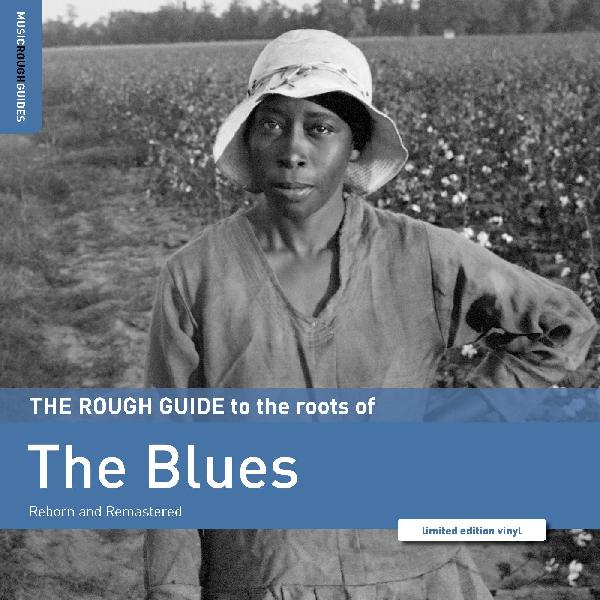
Various - Rough Guide to the Roots of the Blues
World Music Network 1397 on limited edition vinyl
The first documented description of what we now recognise as the blues occurred in 1903 when the composer and musician W.C. Handy was waiting for a train at Tutwiler, Mississippi. He heard a man playing a guitar by pressing a knife against the strings and singing a song with the line, “Goin’ where the Southern cross the Dog”. The song was “the weirdest music I ever heard”, Handy later wrote. But the sound – which he dubbed “the blues”- stuck in his mind. Handy went on to become a great collector and populariser of the blues and was hugely influential in bringing this local folk music from the Mississippi Delta to public attention.
If Handy self-dubbed himself the ‘Father of The Blues” then Ma Rainey must surely be its mother figure. Along with Bessie Smith, Ma Rainey spearheaded the 1920s “classic era” of recorded blues which was dominated by women who lived, performed and recorded in the cities, even if, like Ma Rainey, they brought a country feel to their music. The success of these original blues divas alerted the American record industry to the fact that there was a black audience for gramophone records which in turn spawned the concept of “race records”. Both Ma Rainey’s featured rendition of the classic murder ballad ‘Stack O'Lee Blues’ and Bessie Smith’s seminal version of W.C. Handy’s ‘St. Louis Blues’ were recorded in the mid-1920s heyday of the classic blues era, shortly before the female dominance of the genre was eclipsed by the rougher sound of the country blues.
In stark contrast to the sequined glamour of the classic women blues singers, the country bluesmen typically led a life hobo-ing around the South, performing on street corners, at plantation dances and in barrelhouses. This rougher and more spontaneous guitar-driven form of the blues, often incorporated elements of ragtime, gospel, hillbilly and Dixieland jazz. Its first superstar was Texas bluesman Blind Lemon Jefferson who recorded for Paramount Records in 1926, and whose huge record sales and success led to a flood of other male country blues singers recording during the boom years between 1927 and 1930. Likewise, many white musicians were heavily influenced by the blues including the ‘Father of Country Music’, Jimmie Rodgers whose yodel-infused blues became a prominent element of his music.
There can be little doubt that the blues grew up in the Mississippi Delta as an elaboration on work chants, slave songs, and the lyrical and haunting field hollers. Unquestionably the most influential of all the blues forms, the Delta blues laid the foundations for what was to become rock and roll, with all roads leading to its father figure Charley Patton. An immensely gifted performer, Patton was amazingly prolific and served as a major influence on other legendary bluesmen who followed including Robert Johnson, Muddy Waters and Howlin' Wolf. Along with the guitar, the piano came into its own in the barrelhouses, as roving musicians hammered out high-spirited tunes for the drinkers and dancers. Named after the rough and ready bars where it was formed, ‘barrelhouse’ was a raucous form of piano blues that got the juke joints swinging. This in-turn developed into boogie-woogie with the help of pioneering figures such as Clarence "Pinetop" Smith and Cow Cow Davenport.
Before there was the bluesman there was the songster and it was these traveling troubadours who helped lay the foundations for the development of the blues. In the decades preceding the phonograph and radio and before the American national entertainment industry had reached into the deepest parts of the South, it was these wandering musicians who provided the musical entertainment for all manner of social events. Both Henry Thomas’s ‘Fishing Blues’ and Papa Charlie Jackson’s ‘All I Want Is A Spoonful’ give a tempting glance into a world before the blues came into its own.
TRACK LIST
Mississippi John Hurt: Got The Blues, Can't Be Satisfied 02:50
Cow Cow Davenport: Cow Cow Blues 03:08
Blind Willie McTell: Statesboro Blues 02:30
Ma Rainey: Stack O'Lee Blues 02:52
Blind Lemon Jefferson: See That My Grave Is Kept Clean
Henry Thomas: Fishing Blues
Papa Charlie Jackson: All I Want Is A Spoonful
Charley Patton: Screamin' And Hollerin' The Blues
Blind Willie Johnson: Mother's Children Have A Hard Time
Bessie Smith: St. Louis Blues
Jimmie Rodgers: Blue Yodel No. 1 (T For Texas)
Clarence "Pinetop" Smith: Pinetop's Boogie Woogie
Blind Blake: West Coast Blues
NEW SEALED limited edition vinyl




